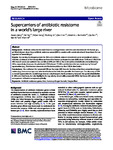Supercarriers of antibiotic resistome in a world’s large river
| dc.contributor.author | Wang, J | |
| dc.contributor.author | Pan, R | |
| dc.contributor.author | Dong, P | |
| dc.contributor.author | Liu, S | |
| dc.contributor.author | Chen, Q | |
| dc.contributor.author | Borthwick, Alistair | |
| dc.contributor.author | Sun, L | |
| dc.contributor.author | Xu, N | |
| dc.contributor.author | Ni, J | |
| dc.date.accessioned | 2022-08-25T11:30:34Z | |
| dc.date.issued | 2022-12 | |
| dc.identifier.issn | 2049-2618 | |
| dc.identifier.issn | 2049-2618 | |
| dc.identifier.other | 111 | |
| dc.identifier.uri | http://hdl.handle.net/10026.1/19577 | |
| dc.description.abstract |
<jats:title>Abstract</jats:title><jats:sec> <jats:title>Background</jats:title> <jats:p>Antibiotic resistome has been found to strongly interact with the core microbiota in the human gut, yet little is known about how antibiotic resistance genes (ARGs) correlate with certain microbes in large rivers that are regarded as “terrestrial gut.”</jats:p> </jats:sec><jats:sec> <jats:title>Results</jats:title> <jats:p>By creating the integral pattern for ARGs and antibiotic-resistant microbes in water and sediment along a 4300-km continuum of the Yangtze River, we found that human pathogen bacteria (HPB) share 13.4% and 5.9% of the ARG hosts in water and sediment but contribute 64% and 46% to the total number of planktonic and sedimentary ARGs, respectively. Moreover, the planktonic HPB harbored 79 ARG combinations that are dominated by “natural” supercarriers (e.g., <jats:italic>Rheinheimera texasensis</jats:italic> and <jats:italic>Noviherbaspirillum</jats:italic> sp. Root189) in river basins.</jats:p> </jats:sec><jats:sec> <jats:title>Conclusions</jats:title> <jats:p>We confirmed that terrestrial HPB are the major ARG hosts in the river, rather than conventional supercarriers (e.g., <jats:italic>Enterococcus</jats:italic> spp. and other fecal indicator bacteria) that prevail in the human gut. The discovery of HPB as natural supercarriers in a world’s large river not only interprets the inconsistency between the spatial dissimilarities in ARGs and their hosts, but also highlights the top priority of controlling terrestrial HPB in the future ARG-related risk management of riverine ecosystems globally.</jats:p> </jats:sec> | |
| dc.format.extent | 111- | |
| dc.format.medium | Electronic | |
| dc.language | en | |
| dc.language.iso | eng | |
| dc.publisher | BioMed Central | |
| dc.subject | Antibiotic resistance genes | |
| dc.subject | Host | |
| dc.subject | Human pathogen bacteria | |
| dc.subject | Yangtze River | |
| dc.subject | Anti-Bacterial Agents | |
| dc.subject | Bacteria | |
| dc.subject | Genes, Bacterial | |
| dc.subject | Humans | |
| dc.subject | Microbiota | |
| dc.subject | Plankton | |
| dc.subject | Rivers | |
| dc.subject | Water | |
| dc.title | Supercarriers of antibiotic resistome in a world’s large river | |
| dc.type | journal-article | |
| dc.type | Journal Article | |
| dc.type | Video-Audio Media | |
| dc.type | Research Support, Non-U.S. Gov't | |
| plymouth.author-url | https://www.ncbi.nlm.nih.gov/pubmed/35897057 | |
| plymouth.issue | 1 | |
| plymouth.volume | 10 | |
| plymouth.publication-status | Published | |
| plymouth.journal | Microbiome | |
| dc.identifier.doi | 10.1186/s40168-022-01294-z | |
| plymouth.organisational-group | /Plymouth | |
| plymouth.organisational-group | /Plymouth/Faculty of Science and Engineering | |
| plymouth.organisational-group | /Plymouth/Faculty of Science and Engineering/School of Engineering, Computing and Mathematics | |
| plymouth.organisational-group | /Plymouth/Users by role | |
| plymouth.organisational-group | /Plymouth/Users by role/Academics | |
| dc.publisher.place | England | |
| dcterms.dateAccepted | 2022-05-15 | |
| dc.rights.embargodate | 2022-8-26 | |
| dc.identifier.eissn | 2049-2618 | |
| dc.rights.embargoperiod | Not known | |
| rioxxterms.versionofrecord | 10.1186/s40168-022-01294-z | |
| rioxxterms.licenseref.uri | http://www.rioxx.net/licenses/all-rights-reserved | |
| rioxxterms.licenseref.startdate | 2022-07-28 | |
| rioxxterms.type | Journal Article/Review |


